St. Luke Building (St. Luke Legacy Center)
Introduction
Text-to-speech Audio
Richmond's St. Luke Building was constructed between 1902 and 1903 and then enlarged in the late 1910s. Today, it is the oldest office building in Richmond connected to the city's Black community. The office building was the site of Maggie L. Walker's private office, where she oversaw the Independent Order of St. Luke until she died in 1934. The hall was used for group meetings of organizations and the building was the original location of the St. Luke Penny Savings Bank in 1903. The bank moved to a new building in 1911 due to a new law prohibiting banks and social clubs in the same building. The Stallings family purchased the building in 1971. In 1982, the St. Luke Building was added to the National Register of Historic Places. The long-vacant building was renovated into a dozen apartments from 2018 to 2020 by the Stallings family, with the main offices of the St. Luke Legacy Center, a nonprofit community center, occupying the ground-floor commercial space.
Images
Photo of "new hall" in 1907 souvenir book on African Americans in Richmond (Ferguson, p. 35)
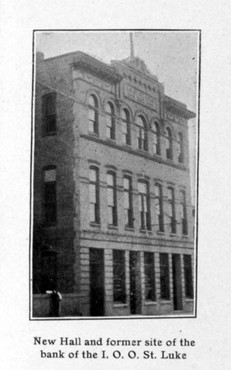
Front of St. Luke Building in 2011 photo (Morgan Riley)
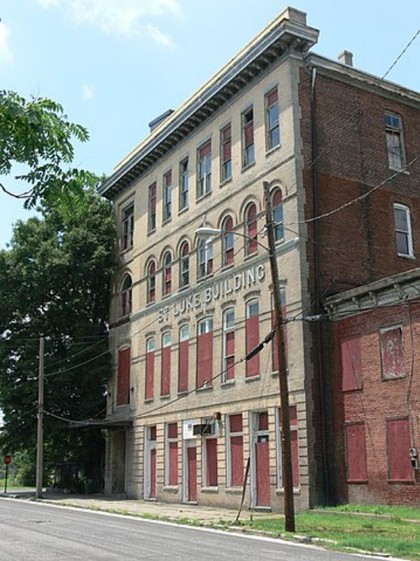
St. Luke's Hall (green arrow) on 1905 Sanborn map (p. 68)
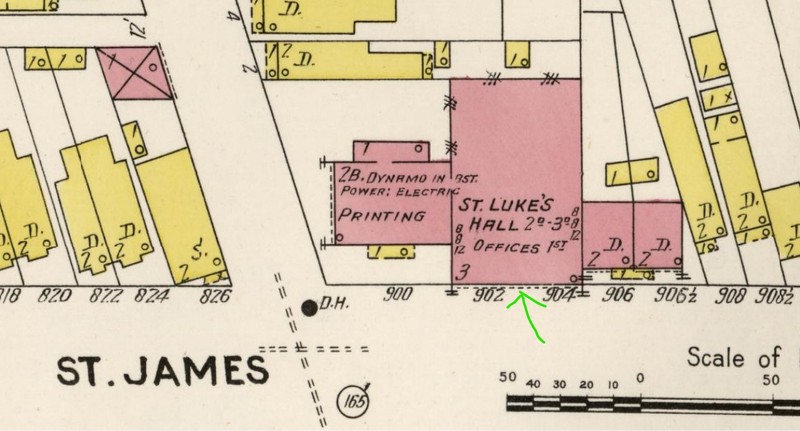
Front of St. Luke Building circa 1981 for NRHP (Virginia Landmarks Commission staff)
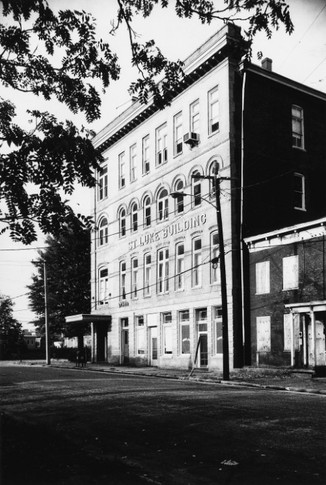
St. Luke Building (green bracket) on 1952 Sanborn map (Vol. 3 p. 326)

Interior stairway in St. Luke Building circa 1981 (Virginia Historic Landmarks Commission staff)
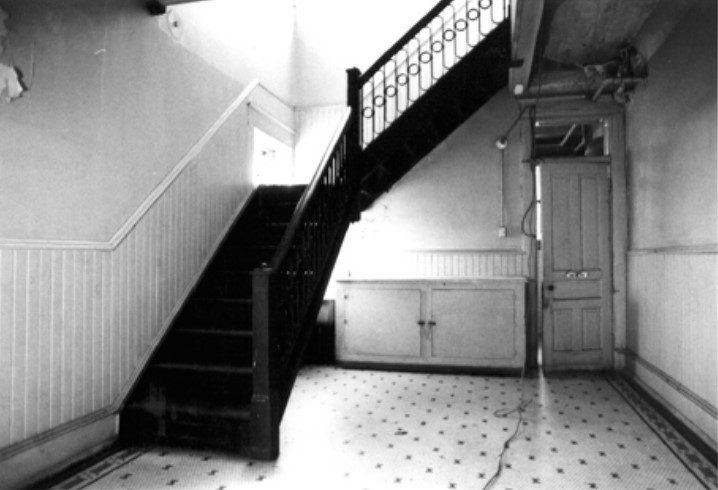
Backstory and Context
Text-to-speech Audio
An ex-slave named Mary Prout established the Independent Order of St. Luke in 1869 in Baltimore; the society provided members financial help surrounding illness and death. The benevolent society's motto was "Love, purity, and charity." A Richmond chapter was established in the late 1800s by Reverend James Holmes and Deacon William White of the First African Baptist Church. Maggie Lena Walker (1867-1934) joined the Order in 1881 while in high school and became its executive secretary in 1899; she was instrumental in getting the Order to move to Richmond. The Richmond home of Walker (location) is a National Historic Landmark (also a Clio entry). Walker started a weekly magazine for the organization, the St. Luke Herald, in 1901.
"St. Luke's Hall" was constructed for the Independent Order of St. Luke to replace its hall in the Church Hill neighborhood. The original part of the building, as constructed from 1902 to 1903, was Edwardian style and designed by John H. White. The main block of the three-story, tan brick building, fronting on St. James St., featured office space on the first floor and the group meeting rooms on the second and third stories (see the 1905 Sanborn map image). A two-story brick wing off of the south side of the building was used as a printing press, with the electric power "dynamo" in the basement. On the south side of the building was a garden. The hall was the site of many group meetings and events. The Union Mercantile and Manufacturing Association held a public meeting in the hall in late March 1903. The Negro Agricultural and Industrial Society of Virginia met there for two days in February 1905.
Maggie Walker set up her office in the new building, which she occupied until her death in 1934. In 1903, Walker established St. Luke's Penny Savings Bank in this building; the bank charter was granted in late July 1903 and the bank's motto was "Bring it all back home." Walker was the first African American woman to found a bank and the first female bank president in the U.S. Two banks had been founded in Richmond by African American men by then but were operated from private homes. The bank opened on November 2, 1903, with a grand celebration of music and speeches. Over $9,000 was deposited on the first day, with depositors from as far away as New York. Emmett C. Burke was the first cashier and Mary Dawson was assistant cashier. Membership in the Order nearly tripled from 1899 to 1910, reaching 20,000. The bank was forced to relocate when a new law in 1910 prohibited banks and social clubs under the same roof. The bank moved in 1911 to a new building at First and Marshall Streets; there is a Clio entry tied to the new location of the bank (329 N. 1st St.).
St. Luke's Hall was remodeled and enlarged from 1915 to 1920 under the plans of Virginia Union University professor Charles T. Russell. The main block was widened with a new (eighth) bay to the south and a fourth floor. Local contractor Henry J. Moore was the builder. The southern wing was demolished. An electrical fire started on a rooftop elevator house in early January 1923 and spread through the roof and part of the fourth floor. Firemen extinguished the fire, but the interior suffered water damage, including the "fine oak desks." In the printing area, the linotype machine was quickly fixed; records were not lost since they were housed in "expensive safe cabinets of the latest design"; the damage was covered by insurance. St. Luke's Penny Savings Bank later merged with the Consolidated Bank and Trust Company. A meeting of stockholders of Consolidated and of the Commercial Bank and Trust Company was held in St. Luke Hall on December 10th, 1930, where the two banks voted to merge. Mrs. Walker, Chairman of the Board of Directors of Consolidated, made a speech of welcome to the new partners. The new bank was headed by Burke as President and Walker as head of the Board of Directors.
After Walker's death in 1934, her office in St. Luke Hall was preserved as she left it. James and Margaret Stallings purchased the "St. Luke Building" from the Order in 1971. In 1981 the building was documented for the National Register of Historic Places nomination. Mr. Stallings was a leading developer of historic properties in the Jackson Ward area. The long-vacant building was still owned by the Stallings family in 2018 when a multi-million-dollar project was begun to renovate the building into apartments with ground-floor commercial space. The twelve apartments, the work of developer Charles Ayers Jr. of River City Ventures, were ready for occupants in early 2020, along with two more apartments in an attached annex. In late 2020, the Stallings family donated thousands of archival records of Mrs. Walker to the National Park Service.
Sources
Anonymous. "Union Mercantile and Manufacturing Association." Richmond Planet (Richmond) March 28th, 1903. 1-1.
Anonymous. "Locals." The Reformer (Richmond) January 28th, 1905. 1-1.
Anonymous. "Fire Damages the St. Luke Hall Here." Richmond Planet (Richmond) January 6th, 1923. 1-1.
Anonymous. "Consolidated - Commercial Banks Merge: Form Huge Banking Institution." Richmond Planet (Richmond) December 13th, 1930. 1-3.
Ferguson, D. A. Souvenir Views: Negro Enterprises & Residences, Richmond, Va.. Richmond, VA. D. A. Ferguson & Co., 1907.
Lazarus, Jeremy M. "Stallings family gets building permit for St. Luke project." Richmond Free Press (Richmond) December 22nd, 2017. online ed.
Lazarus, Jeremy M. "St. Luke building ready for tenants." Richmond Free Press (Richmond) February 8th, 2020. online ed.
National Park Service. Major collection of rare African American archives donated to National Park Service, Maggie L. Walker National Historic Site: News Release. December 8th, 2020. Accessed March 15th, 2024. https://www.nps.gov/mawa/learn/news/major-collection-of-rare-african-american-archives-donated-to-national-park-service.htm.
Ransom, Candice F. Maggie L. Walker: Pioneering Banker and Community Leader. Minneapolis, MN. Twenty-First Century Books, 2009.
Sanborn Map Company. Insurance Maps of Richmond, Virginia. New York, NY. Sanborn Map Company, 1905.
Virginia General Assembly. House Joint Resolution No. 567: on the death of James Russell Stallings Sr., Virginia General Assembly: 2001 Session. January 19th, 2001. Accessed March 15th, 2024. https://lis.virginia.gov/cgi-bin/legp604.exe?011+ful+HJ567ER+pdf.
Virginia Historic Landmarks Commission staff. NRHP nomination of St. Luke Building, 900 St. James St., Richmond, Virginia. National Register of Historic Places. Washington, DC. National Park Service, 1981.
Library of Congress (LOC): https://www.loc.gov/item/74182181/
https://commons.wikimedia.org/wiki/Category:St._Luke_Building_(Richmond,_Virginia)#/media/File:StLukeBuildingRichmondVa.JPG
Library of Congress (LOC): https://www.loc.gov/item/sanborn09064_003/
Virginia Dept. of Historic Resources (VDHR): https://web.archive.org/web/20130813211646/http://www.dhr.virginia.gov/registers/Cities/Richmond/StLukeBuilding_photo.htm
LOC: https://www.loc.gov/item/sanborn09064_018/
VDHR: https://web.archive.org/web/20130813211646/http://www.dhr.virginia.gov/registers/Cities/Richmond/StLukeBuilding_photo.htm
